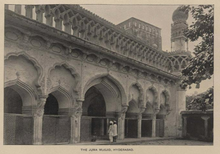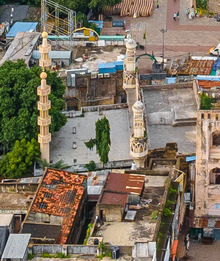| Revision as of 18:04, 3 January 2025 editAmateurHi$torian (talk | contribs)Extended confirmed users2,589 editsNo edit summaryTag: Visual edit← Previous edit | Revision as of 13:51, 4 January 2025 edit undoAmateurHi$torian (talk | contribs)Extended confirmed users2,589 editsNo edit summaryTag: Visual editNext edit → | ||
| Line 8: | Line 8: | ||
| }} | }} | ||
| The '''Jama Masjid''' is a ] in ].<ref name=":1">{{cite book |last1=Khalidi |first1=Omar |url=https://libraries.mit.edu/img/libs/rotch/HyderabadGuide_2009.pdf |title=A Guide to Architecture in Hyderabad, Deccan, India |year=2009 |ref={{sfnref|Khalidi, 2009}} |author-link=Omar Khalidi |access-date= |archive-url=https://web.archive.org/web/20200313131458/https://libraries.mit.edu/img/libs/rotch/HyderabadGuide_2009.pdf |archive-date=2020-03-13 |pp=40}}</ref><ref>{{Cite news |date=2017-09-10 |title=Hyderabad's first Jama Masjid remains consigned to oblivion |work=The Times of India |url=https://timesofindia.indiatimes.com/city/hyderabad/hyderabads-first-jama-masjid-remains-consigned-to-oblivion/articleshow/60445844.cms |access-date=2023-07-23 |issn=0971-8257}}</ref> | The '''Jama Masjid''' is a ] in ].<ref name=":1">{{cite book |last1=Khalidi |first1=Omar |url=https://libraries.mit.edu/img/libs/rotch/HyderabadGuide_2009.pdf |title=A Guide to Architecture in Hyderabad, Deccan, India |year=2009 |ref={{sfnref|Khalidi, 2009}} |author-link=Omar Khalidi |access-date= |archive-url=https://web.archive.org/web/20200313131458/https://libraries.mit.edu/img/libs/rotch/HyderabadGuide_2009.pdf |archive-date=2020-03-13 |pp=40}}</ref><ref>{{Cite news |date=2017-09-10 |title=Hyderabad's first Jama Masjid remains consigned to oblivion |work=The Times of India |url=https://timesofindia.indiatimes.com/city/hyderabad/hyderabads-first-jama-masjid-remains-consigned-to-oblivion/articleshow/60445844.cms |access-date=2023-07-23 |issn=0971-8257}}</ref> The mosque can accommodate about 750 worshippers. | ||
| It is located to the North-East of the ].<ref name=":0">{{Cite book |last=Bilgrami |first=Syed Ali Asgar |url=http://archive.org/details/in.ernet.dli.2015.63136 |title=Landmarks Of The Deccan |date=1927 |pages=26–29}}</ref> | It is located to the North-East of the ].<ref name=":0">{{Cite book |last=Bilgrami |first=Syed Ali Asgar |url=http://archive.org/details/in.ernet.dli.2015.63136 |title=Landmarks Of The Deccan |date=1927 |pages=26–29}}</ref> | ||
| == |
== Background == | ||
| The city of ] was established in the late 16th century by ], the fifth sultan of the ]. The Jama Masjid was built in 1597–98, and was the first mosque to be built in Hyderabad, apart from the small mosque on the first floor of the ]. It was intended to be the ] of the new city. It served this purpose in the initial period after the city's founding, when its population was small. Later, the much larger ] was built to accommodate the city's growing population.<ref name=":1" /><ref>{{Cite book |last=Haig |first=Thomas Wolseley |url=https://en.wikisource.org/Historic_Landmarks_of_the_Deccan |title=Historic Landmarks of the Deccan |page=210}}</ref><ref>{{Cite book |last=Campbell |first=A. C. |url=http://archive.org/details/dli.venugopal.416 |title=Glimpses of the Nizams Dominions |date=1898 |pages=168–169 |language=English}}</ref> | |||
| The mosque underwent heavy restorations during the rule of ].<ref name=":0" /> | The mosque underwent heavy restorations during the rule of ].<ref name=":0" /> | ||
| == Description == | == Description == | ||
| The mosque's facade features seven arches, each composed of two sections. The lower section of each arch is an arched entrance, with the upper section resting on struts that project from the ]. The central arch is wider and taller than the others, and its upper section consists of a ] arch. In contrast, the upper sections of the remaining six arches are ]. A stone ] resting upon ] runs above the arches. Finally, an ornamental ] rises above the facade.<ref>{{Cite book |last=H.k. Sherwani |url=https://archive.org/details/in.ernet.dli.2015.153598/page/n307/mode/2up |title=History Of Medieval Deccan |date=1974}}</ref> | The mosque stands at the western end of a paved courtyard, which measures {{Dimensions|74|70}} feet. The mosque's facade features seven arches, each composed of two sections. The lower section of each arch is an arched entrance, with the upper section resting on struts that project from the ]. The central arch is wider and taller than the others, and its upper section consists of a ] arch. In contrast, the upper sections of the remaining six arches are ]. A stone ] resting upon ] runs above the arches. Finally, an ornamental ] rises above the facade.<ref>{{Cite book |last=H.k. Sherwani |url=https://archive.org/details/in.ernet.dli.2015.153598/page/n307/mode/2up |title=History Of Medieval Deccan |date=1974}}</ref> | ||
| Each front corner has circular ], upon which the front minarets are placed.] | Each front corner has circular ], upon which the front minarets are placed. The interior consists of a double hall, measuring 72', 6" in length and 32', 6" in breadth.] | ||
| === Inscriptions === | === Inscriptions === | ||
Revision as of 13:51, 4 January 2025
Mosque in Hyderabad| Jama Masjid, Hyderabad | |
|---|---|
 | |
| Religion | |
| Affiliation | Islam |
| Location | |
| Location | Hyderabad, Telangana, India |
| Architecture | |
| Style | Qutb Shahi |
The Jama Masjid is a mosque in Hyderabad. The mosque can accommodate about 750 worshippers.
It is located to the North-East of the Charminar.
Background
The city of Hyderabad was established in the late 16th century by Muhammad Quli Qutb Shah, the fifth sultan of the Golconda Sultanate. The Jama Masjid was built in 1597–98, and was the first mosque to be built in Hyderabad, apart from the small mosque on the first floor of the Charminar. It was intended to be the congregational mosque of the new city. It served this purpose in the initial period after the city's founding, when its population was small. Later, the much larger Mecca Masjid was built to accommodate the city's growing population.
The mosque underwent heavy restorations during the rule of Asaf Jah III.
Description
The mosque stands at the western end of a paved courtyard, which measures 74 × 70 feet. The mosque's facade features seven arches, each composed of two sections. The lower section of each arch is an arched entrance, with the upper section resting on struts that project from the piers. The central arch is wider and taller than the others, and its upper section consists of a pointed arch. In contrast, the upper sections of the remaining six arches are cusped. A stone chajja resting upon brackets runs above the arches. Finally, an ornamental parapet rises above the facade.
Each front corner has circular buttresses, upon which the front minarets are placed. The interior consists of a double hall, measuring 72', 6" in length and 32', 6" in breadth.

Inscriptions
The mosque has two inscriptions. The first is above the entrance gate, in Nastaliq script, contains verses praising the ruler and also records the year of construction of the mosque.
The second inscription is located above the prayer niche. The verses 137 and 138 of the second chapter of the Quran are inscribed in the Thuluth script, along with the name of the artist and year of inscription.
References
- ^ Khalidi, Omar (2009). A Guide to Architecture in Hyderabad, Deccan, India (PDF). p. 40. Archived from the original (PDF) on 2020-03-13.
- "Hyderabad's first Jama Masjid remains consigned to oblivion". The Times of India. 2017-09-10. ISSN 0971-8257. Retrieved 2023-07-23.
- ^ Bilgrami, Syed Ali Asgar (1927). Landmarks Of The Deccan. pp. 26–29.
- Haig, Thomas Wolseley. Historic Landmarks of the Deccan. p. 210.
- Campbell, A. C. (1898). Glimpses of the Nizams Dominions. pp. 168–169.
- H.k. Sherwani (1974). History Of Medieval Deccan.
| Qutb Shahi architecture | |
|---|---|
Categories: